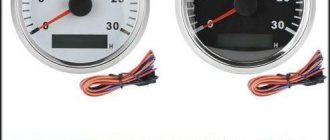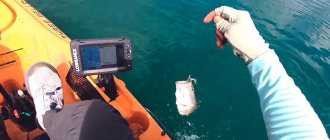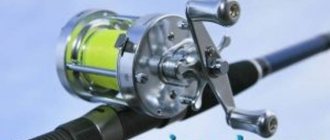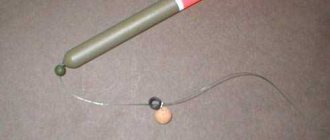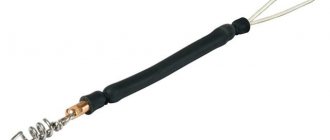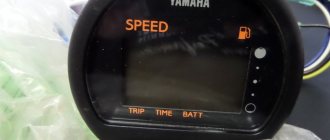What is it for?
Let's take a closer look at what benefits the user receives by installing this device on his boat?
The owner sees the instrument readings and can draw conclusions about:
- Current engine speed.
- See failures in the engine.
- Choose the ideal operating mode - economical and efficient.
- Recognize malfunctions in the engine in time and prevent its breakdown.
- If the motor is new, from the store, and the device is connected, its running-in will be absolutely correct according to the passport.
- Allows you to select the optimal type of propeller.
Types of tachometers
There are several types of meters:
- multi-purpose - for engines of any type;
- for two-stroke engines;
- for four strokes.
In addition there are tachometers:
- analog - the number of revolutions is visible on the dial indicator;
- digital - the alert is displayed.
The first tachometers can measure the number of pulses arriving from the magneto of the engine. Used on modern outboard engines.
The second tachometers read the number of pulses in the ignition system that pass from the power wire to the spark plugs. The process occurs through the insulation of the wires, without violating its integrity, using the induction method. Engine speed is read in real time. So it is not difficult to extract the engine speed. The user also has the opportunity to find out the time during which the engine has been running (motor hours). Here you need a boat universal tachometer.
Used in any engines, even low power ones. They do not require much effort to install them.
But it is necessary to take into account that there are boat engines without a signal from the generator (magneto). The way out is very simple - you need a device with a personal power source.
Types of boat tachometers
The crankshaft rotation speed determines the number of pulses entering the electrical system of the motor. Their number is counted by the tachometer. Magdino coils are generators in boat engines, and the tachometer reads information from them.
Induction tachometers for outboard motors are devices with individual power sources. They are intended for engines that do not have generator signals.
The tachometer recalculates the data and displays the number of crankshaft revolutions over a fixed period of time. Pointer-type indicators or liquid crystal displays are used to display information.
According to their purpose, tachometers are classified into the following types:
- universal (can work with engines of various types);
- two-stroke;
- four-stroke.
The data output type divides devices into two categories:
- analog, having an indicator with arrows;
- digital with a digital display.
Digital tachometers can interact with other measuring devices (hour meters).
What to buy
Buying a tachometer for any outboard motor is quite simple these days. And there is a choice. An affordable device from China or buy an expensive but branded speed meter?
Strictly speaking, both of these devices have the same properties:
- Quite clear image on the display.
- Corresponds to the engine stroke indicators.
- Easy to use.
In addition, there are tachometers that can display, in addition to engine speed, such indicators as:
- engine hours;
- temperature;
- oil pressure.
Most often, universal models are installed. There is a tachometer in the trade plus an hour meter for a marine engine, which, in addition to revolutions, also shows other useful information. This way you can monitor engine wear and prepare for repair or maintenance work on this engine.
It is clear that universal tachometers will require the installation of additional specialized sensors, the installation of which is quite complicated.
For the majority of users, the following are important:
- technical characteristics of the meter;
- ease of installation work for the selected type of device;
- tightness;
- sizes (the more compact the better);
- price.
For digital devices on a boat engine, the following is also relevant:
- speed of message updating;
- brightness and image accuracy.
We have already said that the range of tachometers from various manufacturers is quite extensive. But if the boat has an engine from a brand, say, “Mercury,” then, obviously, it is important for the owner that devices from the same company are installed on the dashboard in order to maintain the design of the boat in the same style. In addition, original parts are a priori of higher quality and reliability, despite their high cost.
Although, it must be admitted that for suspended units the terms “original” and “non-original” are very conditional. Manufacturers of such motors, as a rule, do not have a production base for the production of measuring equipment. There are third-party partner companies for this.
For example, there is this one. It is quite well known as a manufacturer of aftermarket measuring equipment for the powerboat market. And, nevertheless, meters for Mercury engines are produced by Teleflex Marine.
So, let's summarize. It is not at all necessary to focus on an expensive brand of meter, but rather to focus on a boat device that, in appearance, most closely matches the overall design of the vessel, and not its engine. Of course, a very important factor is the price between the “original” and “non-original” device.
"Original" or "universal"?
The choice of tachometers from various brands is quite large, but if, for example, a Mercury engine flaunts on the transom of the boat, then your desire to install a real Mercury device on the dashboard is understandable. In addition, original spare parts are usually considered to be of higher quality and more reliable, although more expensive. We are forced to immediately warn that in relation to tachometers for suspensions, the concepts of “original” and “non-original” are somewhat vague. The fact is that well-known manufacturers of outboard motors, as a rule, do not produce devices for them themselves - the task is entrusted to third-party partner companies. Many have probably heard of, which is perceived primarily as a manufacturer of aftermarket parts and accessories for the powerboat market. But at the same time, instruments for Mercury engines, equipped with the corresponding corporate logo, are produced by it. “Non-original” tachometers with the “Osculati” brand are also her work.
The prices are a complete mess. The simplest “Mercury” tachometer costs just over $100, for the same universal “Osculati” you will be asked 75 euros, and the device will cost almost twice as much - 140 euros! Although all three tachometers are manufactured by the same company and differ only in appearance. Marketing is a delicate thing...
In general, when choosing a tachometer, you can not get hung up on the “native” brand, but look for a device whose appearance most fully matches the design of the control panel, and not the motor - you must agree, this is often more important (“original” dials are usually offered in only two versions - black and white). An important factor, of course, is the price.
The only things that can narrow down the search are four-stroke engines and injection engines. The fact is that the tachometer housing is often used to install warning lamps - say, temperature, oil pressure or "check engine", as well as an hour meter (a simple electronic timer that starts and stops when the ignition is turned on and off), and if you want For these functions to be available, it is better to use a combined instrument. But, we repeat, the tachometer itself, the switch of which is correctly configured, will still work properly.
There are devices that are pre-configured only for motors of a certain brand - for example, combined Suzuki tachometers intended for four-stroke engines do not have a selector, since all DF series engines are equipped only with 12-pole generators. Devices can also have different scale graduations - with the last value from 6 to 8 thousand rpm. This does not have any effect on their interchangeability. For most engines that produce maximum power at 5800–5900 rpm, a scale limited to “six” is quite sufficient, although its only convenience is a slightly greater accuracy of reading due to the extended intervals between divisions. Decide for yourself, but in our opinion, a reserve will not hurt.
As for digital models operating from a spark plug wire, their main advantages are compactness and ease of installation, although many people find it more convenient to read readings from a familiar dial with an arrow.
And although for the most part tachometers are interchangeable, when purchasing, still consult with the seller, since there are exceptions. So, for example, for the correct operation of the same devices with Honda engines with a power of 40 and 50 hp. With. An additional electronic module may be needed to eliminate chaotic needle throwing in the range from idle speed to 1800 rpm.
Price range
Now on prices for engine speed meters. Not everything is so clear here.
Let’s take, for example, an ordinary “Mercury” device for a boat motor. It will cost a little over a hundred dollars. If you have your eye on the universal “Osculati”, then its price is around 75 euros.
If it’s emblazoned on the device, it will cost 145 euros!
Although if you look at it, all three of these devices for outboard motors are made at the same factory and differ only in appearance.
As they say - marketing and nothing more...
Installation process
As a rule, this service is available in specialized studios. A good mechanic will carry out the installation process of the device in accordance with the technical documentation, both for the boat itself and for the tachometer. But there are situations when it is necessary to install the missing element in an area remote from civilization.
But there's nothing to worry about. This operation can be done with your own hands.
The most difficulties arise during installation work in a non-removable instrument panel.
Let's consider this option step by step:
- First you need to decide on the installation location. The dial should not be blocked by the steering wheel in order to be constantly in front of your eyes.
- Using a compass we draw the outline of the future installation location. It must be said that most tachometers have a diameter of 86 mm. Also in the box with the device you can find a paper template of the device on a scale of 1:1. All that remains is to cut it out and try it on the dashboard.
- Next we cut out the hole. An electric drill with a metal core cutter is suitable for this.
- Take care of the branded powerboat wiring harness. Such wires usually come with a corresponding wiring diagram, moisture-proof connectors and lugs. Such a connection will be the most competent and reliable.
- Install the tachometer in place using the original fasteners from the box.
- We connect all the wires together according to the color scheme. The instructions included with the device will help. Plug connectors will significantly speed up this procedure.
- Now all that remains is to connect the battery.
After turning the ignition key, the dial backlight will light up. But we recommend turning on the backlight on a separate toggle switch.
Tips for choosing a device
There are a variety of tachometer models on sale, produced by well-known companies or less popular manufacturers. There is a possibility of purchasing a counterfeit device, so before purchasing it is recommended to look at reviews about the model and consult with friends and acquaintances who have previously purchased similar products.
When choosing, you should consider the following structural features and factors:
- set of functions;
- compatibility of tachometer and boat engine;
- complexity of installation and configuration;
- tightness of the device;
- compact size;
- price.
The device can display only the engine speed or additionally show temperature, number of engine hours, oil pressure and other characteristics. Advanced features require more complex sensor installation.
Typically a device with an engine hour sensor is used. Using this function, a new engine is tested and its service life is determined. It is better to choose a device that records engine hours per trip and their total number since commissioning.
Universal tachometers are equipped with a switch that changes operating modes in accordance with the engine used. Switchless instruments only work with the specific engine types for which they were designed. There are devices that are compatible with motors from a specific manufacturer.
Most often, the power source is located in a sealed case, which will need to be disassembled to replace the battery. This structure allows you to protect the device from water ingress. Some models have a separate cover for the batteries, which makes them easier to remove, but this breaks the seal.
Device prices are significantly higher for models from well-known manufacturers. Such devices often have a large set of functions that increase their cost. Only some of the available functions may be needed to operate the device, so it is advisable to purchase a cheaper and simpler model if the budget is limited.
The digital model should check two parameters:
- frequency of updating data on the screen;
- clarity and brightness of the numbers displayed on the display.
Most popular models
The most popular models of boat tachometers are represented by the following brands:
- Yamaha;
- Mercury;
- Suzuki.
The Yamaha 6Y8T-8350T-11-BK multifunctional digital tachometer has a sealed housing that reliably protects the device from moisture. It is mounted in a standard 86 mm socket on the dashboard and is compatible with Yamaha engines (F 50 and above). The display shows engine hours, maximum and current engine speed. The cost of this model is 23,600 rubles.
Mercury Flagship analogue tachometer (0−8 thousand rpm) can be installed on any variety of Mercuri engines. The device case is resistant to moisture, equipped with anti-fog glass and an arrow dial. The price of an analog tachometer is 5600 rubles.
The Suzuki analog tachometer is used for DF 9.9 and DT 25−40 engines. Installs in a standard 86 mm socket. The model has fog-resistant glass and a sensor that reads up to 7 thousand engine revolutions. Suzuki engines are equipped with 12-pole alternators, so there is no mode switch on the tachometer. The device costs about 4400 rubles.
Settings
Now that the tachometer is installed, you need to make sure that its readings correspond to the actual engine speed.
There is a calibration screw on the back of the meter, but we do not recommend touching it. This means that the device has already been factory configured.
We need to choose the operating mode that matches your type of motor.
There is another graduated screw on the device. This is what you need to set it to the position that corresponds to your type of motor. For each type of motor, this mode of operation of the device is different.
At idle, set the switch mode so that your sensor shows 550–1250 rpm.
If the device was purchased based on the characteristics of your engine, then when you start it, it will most likely already show the correct speed.
